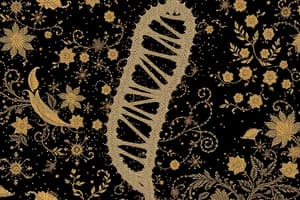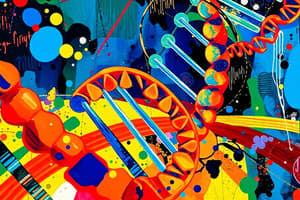Podcast
Questions and Answers
Which significant discovery is Francis Crick known for?
Which significant discovery is Francis Crick known for?
- Mechanism of photosynthesis
- Structure of RNA
- Structure of DNA (correct)
- Role of nucleotides in protein synthesis
Which university did Francis Crick attend for his graduate work?
Which university did Francis Crick attend for his graduate work?
- University of California, Berkeley
- University of Cambridge
- University College London (correct)
- University of Zurich
What research area did Crick and Watson primarily focus on during their collaboration?
What research area did Crick and Watson primarily focus on during their collaboration?
- Structure of DNA (correct)
- Viscosity of water
- Structure of proteins
- Composition of nucleic acids
Which dimension of molecular biology did Crick explore during his time at the Cavendish Laboratory?
Which dimension of molecular biology did Crick explore during his time at the Cavendish Laboratory?
What year did Crick and Watson publish their groundbreaking paper on DNA?
What year did Crick and Watson publish their groundbreaking paper on DNA?
Who did Francis Crick collaborate with on the DNA structure discovery?
Who did Francis Crick collaborate with on the DNA structure discovery?
In what atmosphere did Crick's PhD studies occur?
In what atmosphere did Crick's PhD studies occur?
Which scientific methodology did Crick and Watson predominantly utilize for their DNA research?
Which scientific methodology did Crick and Watson predominantly utilize for their DNA research?
What significant discovery are Francis Crick and James Watson known for?
What significant discovery are Francis Crick and James Watson known for?
In which year did Crick complete his PhD?
In which year did Crick complete his PhD?
Which prestigious award did Francis Crick receive in 1962?
Which prestigious award did Francis Crick receive in 1962?
What was one of the areas Crick focused on after moving to California?
What was one of the areas Crick focused on after moving to California?
What method did Crick initially use in his research before transitioning to biology?
What method did Crick initially use in his research before transitioning to biology?
Who did Crick collaborate with to unlock the molecular structure of DNA?
Who did Crick collaborate with to unlock the molecular structure of DNA?
In what year did Crick begin his PhD at the Cavendish Laboratory?
In what year did Crick begin his PhD at the Cavendish Laboratory?
What title was Crick awarded in 1976 at the Salk Institute?
What title was Crick awarded in 1976 at the Salk Institute?
Who is credited with the identification of the neutron?
Who is credited with the identification of the neutron?
What did Rutherford's atomic model suggest about the structure of the atom?
What did Rutherford's atomic model suggest about the structure of the atom?
What surgical procedure did António Egas Moniz develop?
What surgical procedure did António Egas Moniz develop?
In what year did António Egas Moniz invent the angiogram?
In what year did António Egas Moniz invent the angiogram?
Which scientist is associated with the phrase about the atom being a 'nice hard fellow'?
Which scientist is associated with the phrase about the atom being a 'nice hard fellow'?
What did Rutherford's atomic model challenge about previous atomic theories?
What did Rutherford's atomic model challenge about previous atomic theories?
Which of the following contributions is NOT attributed to António Egas Moniz?
Which of the following contributions is NOT attributed to António Egas Moniz?
What aspect of the atom was first introduced in Rutherford's model?
What aspect of the atom was first introduced in Rutherford's model?
Flashcards
Cepheid Variable Star
Cepheid Variable Star
A type of star that pulsates, changing its brightness in a regular pattern.
Nova
Nova
A powerful, short-lived explosion on a star's surface, briefly making it much brighter.
Miller-Urey Experiment
Miller-Urey Experiment
The first experiments using a closed system to simulate Earth's early atmosphere and create organic compounds from simple gases.
Stellar Photometry
Stellar Photometry
Signup and view all the flashcards
Cosmic Distance
Cosmic Distance
Signup and view all the flashcards
Molecular Biology
Molecular Biology
Signup and view all the flashcards
Double Helix
Double Helix
Signup and view all the flashcards
Abiogenesis
Abiogenesis
Signup and view all the flashcards
Rutherford's Atomic Model
Rutherford's Atomic Model
Signup and view all the flashcards
Neutron
Neutron
Signup and view all the flashcards
Angiogram
Angiogram
Signup and view all the flashcards
Frontal Lobotomy
Frontal Lobotomy
Signup and view all the flashcards
Rutherfordium
Rutherfordium
Signup and view all the flashcards
António Egas Moniz
António Egas Moniz
Signup and view all the flashcards
University of Lisbon
University of Lisbon
Signup and view all the flashcards
Frontal Lobotomy in Psychiatry
Frontal Lobotomy in Psychiatry
Signup and view all the flashcards
Who is Francis Crick?
Who is Francis Crick?
Signup and view all the flashcards
What was Crick's early career?
What was Crick's early career?
Signup and view all the flashcards
Where did Crick start his research on DNA?
Where did Crick start his research on DNA?
Signup and view all the flashcards
What breakthrough did Crick and Watson achieve?
What breakthrough did Crick and Watson achieve?
Signup and view all the flashcards
How was Crick's work recognized?
How was Crick's work recognized?
Signup and view all the flashcards
Where did Crick continue his research after his Nobel Prize?
Where did Crick continue his research after his Nobel Prize?
Signup and view all the flashcards
What were some of Crick's other areas of scientific research?
What were some of Crick's other areas of scientific research?
Signup and view all the flashcards
What is the overarching theme of Francis Crick's life story?
What is the overarching theme of Francis Crick's life story?
Signup and view all the flashcards
Study Notes
Scientists Who Changed History
- This book details the lives and significant contributions of various historical scientists.
- It highlights key milestones, discoveries, and achievements of these individuals.
- The book covers several fields of science, including physics, biology, medicine, and more.
Studying That Suits You
Use AI to generate personalized quizzes and flashcards to suit your learning preferences.




